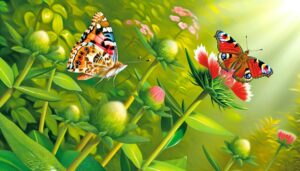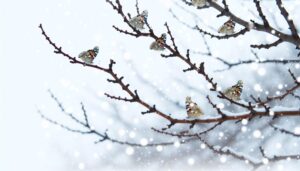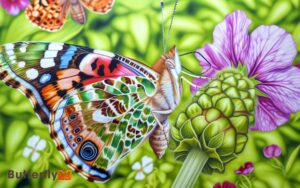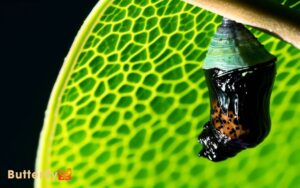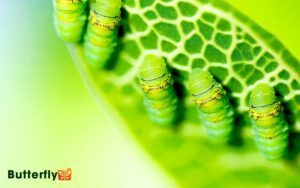Painted Lady Butterflies on Radar: Discover the Phenomenon!
Radar technology has revolutionized the tracking of Painted Lady butterflies, shedding light on their extensive migratory routes between North Africa and Europe.
Utilizing Doppler radar to measure velocity and direction, scientists can now differentiate butterflies from other objects.
High-frequency radar waves and machine learning enhance data accuracy, revealing flight paths, altitudes, and speeds. These insights uncover how environmental factors influence their migration and identify critical stopover sites.
Understanding these complex navigation mechanisms and behavioral adaptations offers a glimpse into their survival strategies and highlights the need for conservation efforts.
Discover more about how these innovations are transforming our view of butterfly migration.
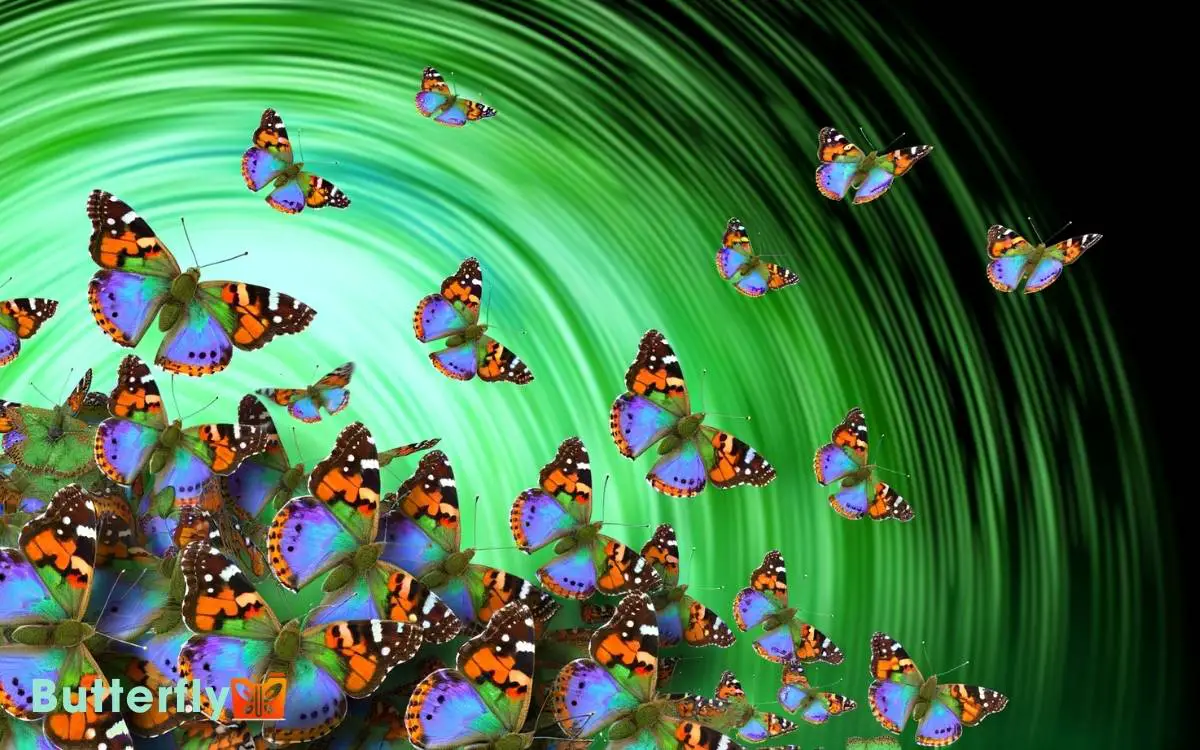
Key Takeaways
Migration Patterns
The migration patterns of Painted Lady butterflies are characterized by their long-distance travel, which can be tracked using radar technology.
These butterflies undertake extensive journeys, sometimes spanning thousands of kilometers, driven by seasonal changes and food availability.
They typically migrate from North Africa to Europe in spring and return in autumn. Painted Ladies exhibit a unique, multi-generational migration, meaning multiple generations complete the full migratory circuit.
Observations reveal that they fly at high altitudes, utilizing favorable wind currents to conserve energy. This strategic use of wind assists them in covering vast distances efficiently.
Researchers have documented that these butterflies can travel up to 500 kilometers in a single day, demonstrating remarkable endurance and navigational skills.
Technology Intersection
Researchers have harnessed advanced radar technology to track the intricate migration patterns of Painted Lady butterflies. By analyzing radar data, scientists can observe flight behaviors, altitudes, and travel trajectories with high precision.
This integration of technology provides unprecedented insights into the species’ migratory habits and environmental influences.
Radar Tracking Innovations
Advancements in radar technology have revolutionized the ability to track the migratory patterns of Painted Lady butterflies with unprecedented accuracy.
Modern radar systems employ Doppler technology, which measures the velocity and direction of the butterflies in real-time.
These systems can detect even small, low-flying insects over extensive distances. The integration of automated algorithms allows for the differentiation between butterflies and other airborne entities, ensuring precise data collection.
Researchers utilize these innovations to record detailed flight paths, altitudes, and speeds, providing invaluable insights into the species’ behavior.
The combination of high-frequency radar waves and machine learning enhances the resolution and reliability of the tracking data, enabling scientists to monitor these delicate creatures with remarkable detail and consistency.
Migration Patterns Analysis
Combining radar tracking innovations with advanced data analytics, scientists can now dissect and interpret the intricate migration patterns of Painted Lady butterflies with unparalleled precision.
These butterflies, known for their long-distance migratory behavior, traverse thousands of kilometers between Europe and Africa.
By integrating high-resolution radar data with machine learning algorithms, researchers can identify specific flight paths, altitudes, and speeds.
This technological synergy reveals critical insights into how environmental factors like wind currents and temperature gradients influence migration routes.
Additionally, data analytics allow for the visualization of population dynamics over time, showcasing trends and anomalies in migration behavior.
This in-depth understanding aids conservation efforts, ensuring that habitats essential for the butterflies’ survival are protected and maintained.
Radar Detection
Modern radar technology has enabled scientists to detect and track the large-scale movements of Painted Lady butterflies with thorough accuracy.
Utilizing Doppler radar, researchers can distinguish these butterflies from other aerial objects based on their unique wingbeat frequency and flight patterns.
The radar’s ability to provide real-time data allows for the observation of migration routes and altitude preferences.
By analyzing radar echoes, scientists can estimate population density and speed. This technology not only identifies individual butterflies but also captures entire swarms, offering a detailed view of their migration dynamics.
The integration of radar data with meteorological conditions further enhances the understanding of how environmental factors influence their migratory behavior.
Scientific Discoveries
Researchers have uncovered remarkable scientific discoveries by leveraging radar technology to study the migratory patterns of Painted Lady butterflies.
By employing entomological radar, scientists have tracked these insects’ extensive migratory routes, revealing that they can travel thousands of kilometers.
This technology has enabled precise measurements of flight altitude, speed, and direction, providing invaluable data on their long-distance flights.
Additionally, radar has shown that Painted Ladies utilize favorable wind currents, optimizing their energy expenditure during migration.
Detailed radar observations have even identified stopover sites that are vital for their survival, offering critical insights into their migration ecology.
These findings enhance the understanding of Painted Lady butterflies’ navigation mechanisms and contribute to broader ecological and conservation efforts. By studying these patterns, researchers can better predict migration routes and assess environmental factors affecting butterfly populations. Integrating painted lady butterfly facts into educational programs also raises awareness about their vital role in ecosystems. Such insights ultimately support conservation strategies to protect these remarkable insects and their habitats.
Behavioral Insights
Analyzing radar data reveals intricate details about the Painted Lady butterflies’ behavioral adaptations during migration. These insects exhibit remarkable navigational skills, adjusting their flight altitude to exploit favorable wind currents.
Radar observations demonstrate their ability to form cohesive migratory groups, enhancing their aerodynamic efficiency.
Additionally, Painted Ladies show diurnal activity patterns, typically flying during daylight hours when temperatures are ideal.
| Behavioral Adaptation | Observation |
|---|---|
| Altitude Adjustment | Utilize wind currents |
| Group Formation | Increased aerodynamic efficiency |
| Diurnal Activity Patterns | Fly during daylight for ideal temps |
Such insights highlight the butterflies’ sophisticated behavioral strategies, ensuring successful long-distance travel. By leveraging radar data, scientists can better understand and preserve these migratory phenomena.
Migration Challenges
Painted Lady butterflies encounter significant migration challenges, including adverse weather conditions that can hinder their progress. Predators and environmental threats also pose substantial risks, impacting survival rates during long journeys.
Additionally, these butterflies must rely on complex navigation and orientation mechanisms to reach their destinations.
Weather Impact on Migration
Given these circumstances, weather patterns greatly influence the migration routes of Painted Lady butterflies. Sudden changes in wind direction and temperature can pose substantial challenges to their long-distance travel.
These butterflies rely on favorable tailwinds to conserve energy during their extensive journeys. Unexpected headwinds can force them to expend extra energy, potentially leading to exhaustion and reduced survival rates.
Temperature fluctuations also affect their flight ability; cooler temperatures can slow their metabolism, reducing flight endurance. Conversely, extreme heat can lead to dehydration.
Additionally, precipitation can impede their progress by making flight difficult and increasing the risk of predation.
Therefore, understanding and predicting weather conditions are critical for scientists studying the migration patterns and survival strategies of Painted Lady butterflies.
Predators and Threats
Numerous predators and environmental threats pose significant challenges to the migration of Painted Lady butterflies. Birds, spiders, and predatory insects often prey on these butterflies.
Additionally, adverse weather conditions, such as heavy rains and strong winds, can hinder their migration by causing physical harm or disorientation.
Exposure to pesticides and habitat destruction further exacerbates their perilous journey. These factors collectively impact their survival and successful migration.
| Predators | Environmental Threats | Human-induced Threats |
|---|---|---|
| Birds | Heavy rains | Pesticides |
| Spiders | Strong winds | Habitat destruction |
| Predatory insects | Temperature extremes | Pollution |
Understanding these threats is crucial for developing conservation strategies that enhance the resilience of Painted Lady butterflies during migration.
Navigation and Orientation
Understanding how Painted Lady butterflies navigate and orient themselves during migration involves examining their use of environmental cues, such as the sun’s position and Earth’s magnetic field.
These butterflies face immense challenges during their journeys, relying on intricate biological mechanisms to maintain their course.
Key factors include:
- Sun Compass: Painted Ladies use the sun’s position to gauge direction, adjusting their flight paths throughout the day.
- Magnetic Field: They detect Earth’s magnetic field, helping them stay oriented even on cloudy days.
- Wind Patterns: Wind can aid or impede their migration, requiring adaptive responses to varying atmospheric conditions.
Their ability to interpret these cues with precision underscores the complexity of their migratory behavior, revealing a remarkable interplay between biology and the environment.
Future Research
Future research will focus on enhancing radar technology to better track the migration patterns of Painted Lady butterflies. Scientists aim to develop more sensitive radar systems capable of detecting smaller, faster-moving insects.
By improving resolution and data accuracy, researchers can gain insights into flight altitude, speed, and direction.
Additionally, integrating radar data with environmental variables like wind speed and temperature will help elucidate how these factors influence butterfly migration.
Advanced machine learning algorithms will be employed to analyze vast datasets, identifying patterns and anomalies.
This research will also explore miniaturized tracking devices that can be attached to butterflies without affecting their natural behavior. Such innovations promise a deeper understanding of Painted Lady butterflies’ complex migratory journeys.
Conservation Implications
The enhanced tracking of Painted Lady butterflies through advanced radar technology carries significant conservation implications by enabling more accurate monitoring of population dynamics and migratory routes.
This technology allows scientists to:
- Identify critical habitats: Detecting key areas essential for breeding and survival.
- Assess population health: Monitoring fluctuations in butterfly numbers to detect declines or recoveries.
- Inform conservation strategies: Tailoring measures to protect crucial migratory corridors and habitats.
Accurate data on these butterflies’ movements guarantees that conservation efforts are targeted and effective. Their migratory patterns can indicate broader environmental changes, making them essential bioindicators.
Conclusion
In a summary, the convergence of technology and nature has exposed the intricate migration patterns of painted lady butterflies.
Radar detection has provided groundbreaking scientific discoveries, offering detailed insights into their behavior and migration challenges.
As researchers continue to peel back the layers of mystery, future studies will unquestionably advance knowledge and conservation efforts.
The journey of these butterflies reminds us that even the smallest creatures can reveal significant secrets when viewed through the lens of modern technology.


